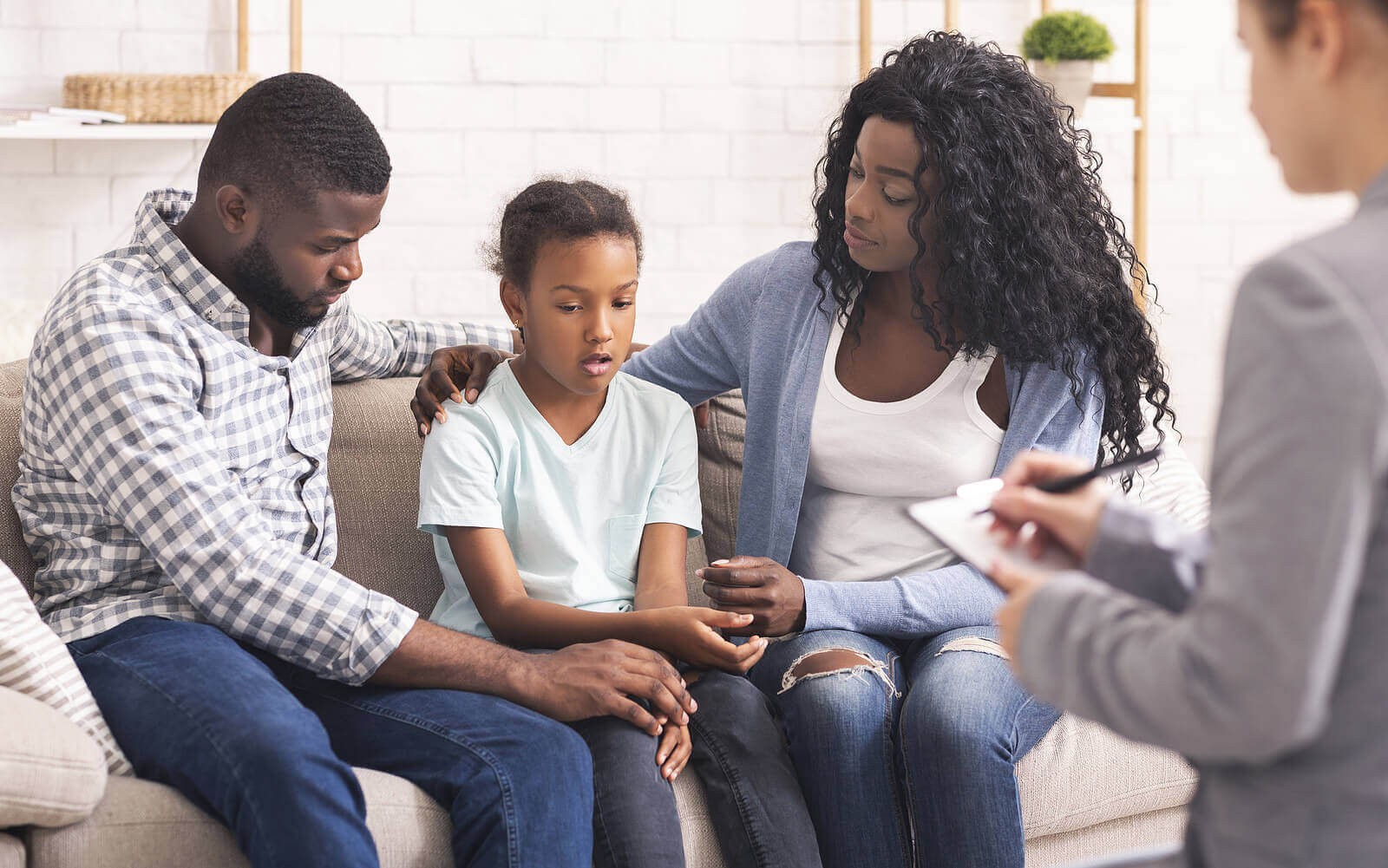Emotional Therapy for Children


Written and verified by the psychologist Elena Sanz Martín
It’s common to hear mothers and fathers talk naturally about how their children go to speech therapy or motor therapy. We all understand that we need to give our children the support they need if they have difficulties in these areas. However, unfortunately, there’s a certain stigma when it comes to emotional therapy for children… Even though we all know that this is an important aspect of their development.
Resistance when it comes to emotional therapy may have to do with simple ignorance. Many still think that only children and adults with severe disorders need to see a psychologist. We may also experience feelings of guilt or shame when we feel incapable of educating our children on our own.
The truth is that psychotherapy is very beneficial and necessary when it comes to any difficulty that children may experience. Seeing a therapist doesn’t mean a child has major issues or that their parents are incapable or negligent. Quite the opposite is true.
Giving your children the support they need is an act of love and responsibility. Parents don’t always have all the answers, and looking for professional assistance is very beneficial.
When is emotional therapy for children necessary?
There is a variety of situations that can produce intense emotions in children that are difficult to handle. Pay attention to their behaviors and attitudes, as this is the best way to detect if they’re experiencing difficult emotions.

In some cases, children will display sudden mood changes, and become apathetic and disinterested in activities they used to enjoy. Or they may seem distracted and have a hard time paying attention at school. Children may also become irritable, have out-of-control tantrums, become more challenging or more withdrawn.
In general, problems at school, at home, or with friends may have to do with an emotional problem. But the following are some of the events that most frequently cause emotional suffering in children:
- Divorce.
- Illnesses, operations, and hospitalizations.
- The death of a loved one.
- Family problems, conflicts, or violence.
- Major life changes: The birth of a sibling, a move, changing to a new school, etc…
What does emotional therapy with children involve?
First of all, it’s important to understand that therapy with children is completely different than therapy with adults. What’s more, it adapts to each child’s age and capacities. The following are some of the main elements that it involves.
The relationship with the therapist
It’s crucial that children feel comfortable with the person that’s going to accompany them in this process. In other words, the therapist needs to inspire a sense of trust and safety and needs to be in sync with the child. Perhaps the first therapist you see meets these criteria, but that’s not always the case. So, don’t hesitate to try with someone else until you find the right fit.
Play
Emotional therapy with children includes elements that make it more accessible for little ones. Both during the diagnostic phase as well as during treatment, professionals use play, drawing, and different toys and dolls. Children find themselves in a safe and relaxed setting that allows them to express themselves in a way that’s natural and comfortable.

Don’t think that your child’s going to spend the entire session sitting on a couch talking about issues that they don’t understand or answering deep questions. In reality, it’s a process with which children need to feel very at ease, meaning that the format of therapy sessions will adapt to them.
Emotional intelligence
The objective of emotional therapy for children is to develop emotional intelligence. This is a quality that’s shown to be related to happiness, satisfaction, better academic performance, and more fulfilling social relations.
So, through a variety of games and dynamics, children learn to recognize and identify different emotions. What’s more, they learn that all emotions are valid – it’s okay to be angry or sad sometimes – and to express them in a healthy way.
In the end, children are more able to understand their own emotions and where they come from. And furthermore, they’ll possess the tools they need to handle them and not suffer because of them. Therefore, if you think your little one could benefit from some help with their emotions, don’t hesitate to consult a professional.
It’s common to hear mothers and fathers talk naturally about how their children go to speech therapy or motor therapy. We all understand that we need to give our children the support they need if they have difficulties in these areas. However, unfortunately, there’s a certain stigma when it comes to emotional therapy for children… Even though we all know that this is an important aspect of their development.
Resistance when it comes to emotional therapy may have to do with simple ignorance. Many still think that only children and adults with severe disorders need to see a psychologist. We may also experience feelings of guilt or shame when we feel incapable of educating our children on our own.
The truth is that psychotherapy is very beneficial and necessary when it comes to any difficulty that children may experience. Seeing a therapist doesn’t mean a child has major issues or that their parents are incapable or negligent. Quite the opposite is true.
Giving your children the support they need is an act of love and responsibility. Parents don’t always have all the answers, and looking for professional assistance is very beneficial.
When is emotional therapy for children necessary?
There is a variety of situations that can produce intense emotions in children that are difficult to handle. Pay attention to their behaviors and attitudes, as this is the best way to detect if they’re experiencing difficult emotions.

In some cases, children will display sudden mood changes, and become apathetic and disinterested in activities they used to enjoy. Or they may seem distracted and have a hard time paying attention at school. Children may also become irritable, have out-of-control tantrums, become more challenging or more withdrawn.
In general, problems at school, at home, or with friends may have to do with an emotional problem. But the following are some of the events that most frequently cause emotional suffering in children:
- Divorce.
- Illnesses, operations, and hospitalizations.
- The death of a loved one.
- Family problems, conflicts, or violence.
- Major life changes: The birth of a sibling, a move, changing to a new school, etc…
What does emotional therapy with children involve?
First of all, it’s important to understand that therapy with children is completely different than therapy with adults. What’s more, it adapts to each child’s age and capacities. The following are some of the main elements that it involves.
The relationship with the therapist
It’s crucial that children feel comfortable with the person that’s going to accompany them in this process. In other words, the therapist needs to inspire a sense of trust and safety and needs to be in sync with the child. Perhaps the first therapist you see meets these criteria, but that’s not always the case. So, don’t hesitate to try with someone else until you find the right fit.
Play
Emotional therapy with children includes elements that make it more accessible for little ones. Both during the diagnostic phase as well as during treatment, professionals use play, drawing, and different toys and dolls. Children find themselves in a safe and relaxed setting that allows them to express themselves in a way that’s natural and comfortable.

Don’t think that your child’s going to spend the entire session sitting on a couch talking about issues that they don’t understand or answering deep questions. In reality, it’s a process with which children need to feel very at ease, meaning that the format of therapy sessions will adapt to them.
Emotional intelligence
The objective of emotional therapy for children is to develop emotional intelligence. This is a quality that’s shown to be related to happiness, satisfaction, better academic performance, and more fulfilling social relations.
So, through a variety of games and dynamics, children learn to recognize and identify different emotions. What’s more, they learn that all emotions are valid – it’s okay to be angry or sad sometimes – and to express them in a healthy way.
In the end, children are more able to understand their own emotions and where they come from. And furthermore, they’ll possess the tools they need to handle them and not suffer because of them. Therefore, if you think your little one could benefit from some help with their emotions, don’t hesitate to consult a professional.
All cited sources were thoroughly reviewed by our team to ensure their quality, reliability, currency, and validity. The bibliography of this article was considered reliable and of academic or scientific accuracy.
- Shapiro, L. E., & Tiscornia, A. (1997). La inteligencia emocional de los niños. Javier Vergara.
- Garrido, A. (2016, 27 diciembre). Los niños en terapia también juegan. Recuperado julio de 2020, de https://lamenteesmaravillosa.com/los-ninos-en-terapia-tambien-juegan/
This text is provided for informational purposes only and does not replace consultation with a professional. If in doubt, consult your specialist.








